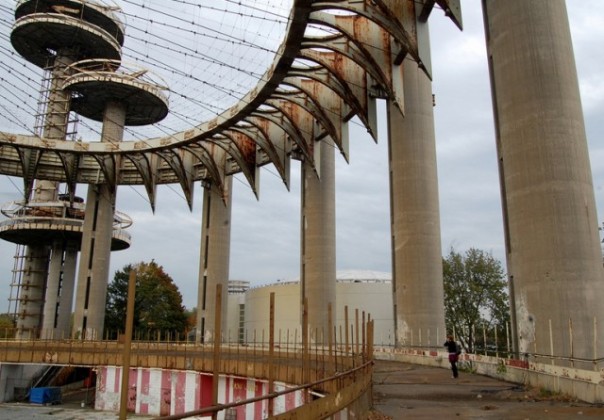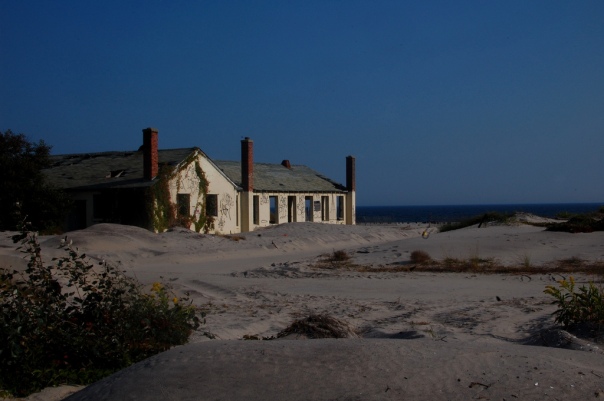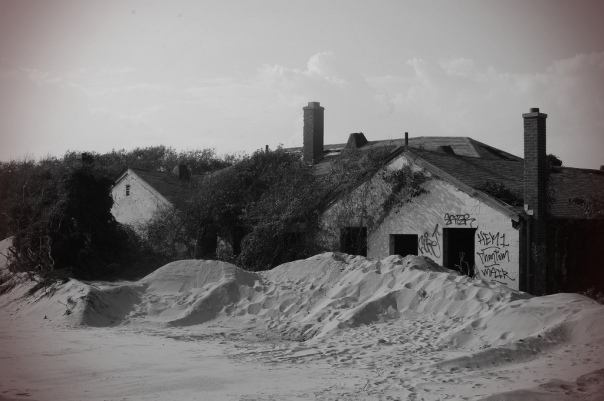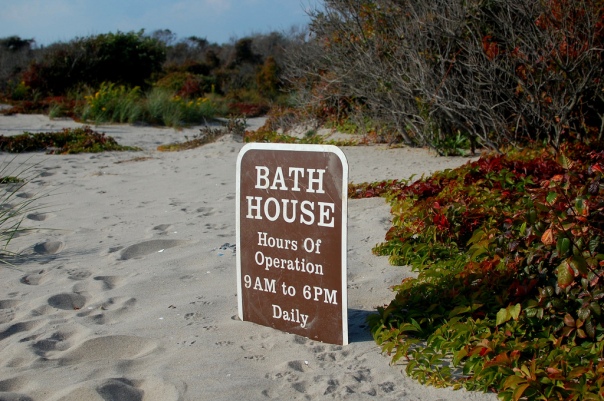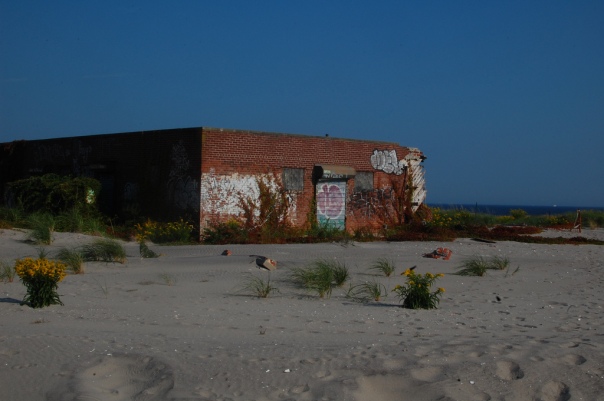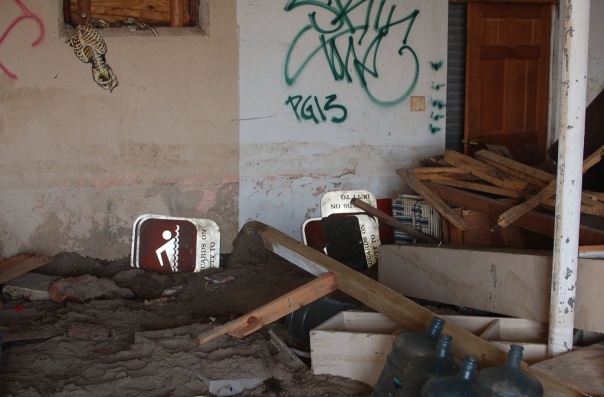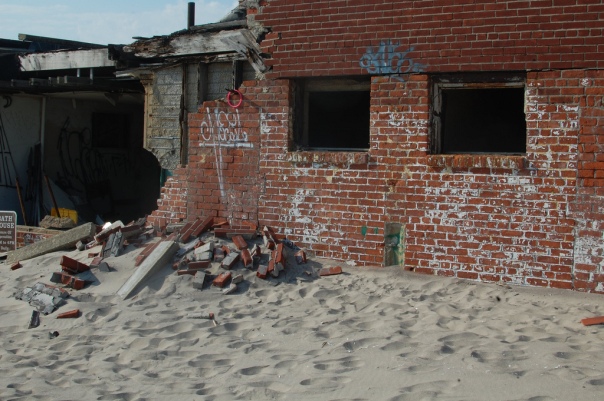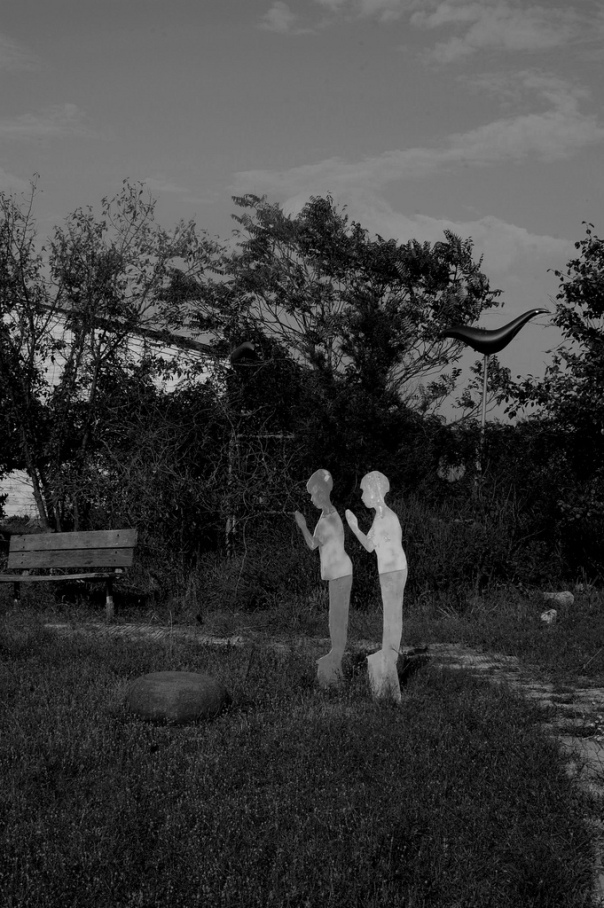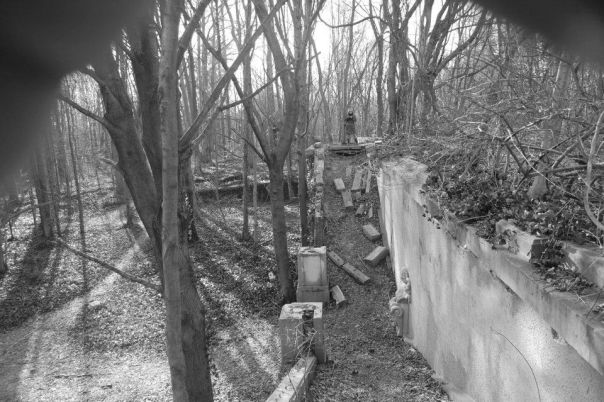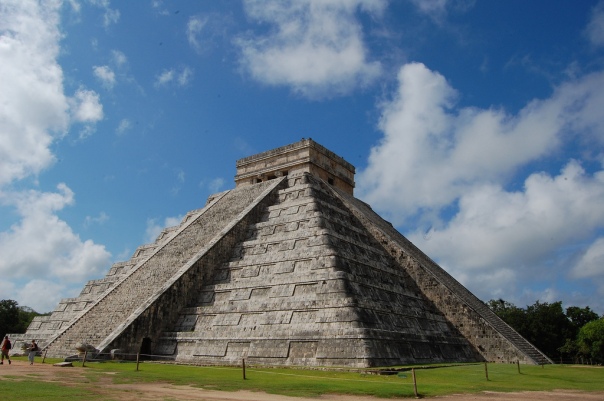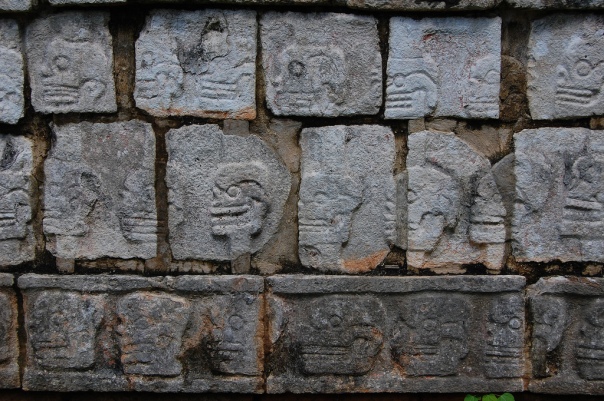Blog Archives
Walking the Queens World’s Fair Ruins – Seen on Gothamist
I took this photo some time ago along with others documenting the crumbling World’s Fair Grounds of Flushing Meadows-Corona Park.
It was featured on Friday’s Gothamist. $43 million is needed to restore the facilities and save them from destruction.
More of my pictures of the place are here: https://ventilateblog.wordpress.com/tag/worlds-fair-grounds/
Fort Tilden Revisited – one year after the Storm
A century ago, guardian of the Atlantic approach to NY Harbor. Artillery with a range of 25-miles pointed seaward waiting for the German ships that never came – save perhaps for a handful of shadowy U-boats, seen and unseen.
A patch of sandy desolation on the fragile narrow spit of the Rockaway Peninsula, which barely rises between ocean and the Jamaica Bay. In the distance, a proud Manhattan skyline – a mirage of a completely different world – hazy and not quite existent.
Wars of the sea gave way to wars of the air. The big guns were traded in for the Nikes, missiles designed to knock high-altitude Soviet bombers out of the Metropolitan sky.
And then, a few decades ago – total obsolescence, abandonment, and decay. Gutted shells, overgrown and sinking into the sand, which in turn, minute by minute, sinks into the waves. It’s lately been a playground of the fringes – artists, photographers, graffiti, and seekers of ramshackle ephemera.
The hurricane pummelled the city, and the peninsula took a huge punch, a slap in the face of human futility. For that night, the peninsula did not exist, but became ocean and bay – Neighborhoods near the isolated base washed away and burned. Sand piled high like snow drifts that never melt, overturned cars, buried homes and memories.
Pieces of Tilden dissolved into the waves. But what is already ruined is hard to ruin again. At this former fort, a few solid walls are down, the sand mounts high, and a faint, musty, low-tide smell still faintly emits from the ground below. But the gun battery embedded in the bluffs still stares blankly into the sea, awaiting 100-year-old dreadnoughts and battleships that will never appear. Since the Storm, it’s become barricaded, forbidden, heavily patrolled by the authorities – a no man’s land – A silent sentinel upon the wild dunes of a wild beach on the barren coastal fringes of the City.
King Zog’s Gold Coast Palace
Through the 1920’s and ’30’s, Ahmet Muhtar Zoggolli, a.k.a. Zog I, was prime minister of, president of, and finally, King of Albania. Among other eccentricities, he holds the world record for number of cigarettes smoked in one day (225!), and is said to have survived 55 assassination attempts- in one case, he personally engaged in a gun fight with an attacker.
“Oh God, it was so short” he uttered when he was exiled by invading Italian armies in 1939.
He and his family wandered Britain and Egypt, and in 1951 purchased the early-20th century Knollwood Estate in the Gold Coast of Long Island, New York.
He planned to bring his entire court to the U.S., but immigration laws impeded this. The entire American endeavor was a sad failure.
Zog eventually died in Paris ten years later. His Queen Geraldine passed in 2002.
It has been suggested that King Zog bought the Estate with diamonds and rubies, and that hidden treasure lay on or under the grounds.
After being ditched in the late ’50’s, it was torn down to prevent looting. So complete was the annihilation that only a few specks remain of the 60-room palatial mansion. The only remains are the front gate, a couple of gazebos, the base of a loggia, some garden walls… The most prominent survivor is the double staircase that led to what was once the front patio.
The silence here is striking and strange. Subtle traces of stonework emerge from the brambles, and you begin to notice features of the overgrowth that reveal landscaped patterns- well-aligned rows of large trees and such.
Ghosts abound. Echoes of all those who passed through what is now a sad patch of forest. Cigars smoked, gatherings had, all manner of passions and frustrations. Holidays, births, deaths, visits- all the trappings of both grand and humble living.
The ruins of Chichén Itzá
Nestled deep in the forests of the interior of Mexico’s Yucatán Peninsula sits one of the world’s foremost archeological sites – Chichén Itzá.
It was a city built to intimidate, influence, inspire, and empower- and as such, it is not at all unlike the cities we know and live in today. The practices carried out here were so alien to what most of us know today, but nevertheless, we can still understand what it is like to exist in a certain time and place, and to define where we are as home, for all better or worse.
The ruined buildings here display a great deal of imperious civic pride. But it’s thinking about the day-to-day that is most compelling. Countless people walked these streets, entered these buildings- each with their own hopes, dreams, and intrigues. Each trying, within the society they were brought up in, to make sense of the world around them. Each with their pleasures, vices, gripes, and shortcomings. Some with imagination that could vault the stars. Some who devoted themselves wholly to the city and society around them, and surely others who dissented, perhaps quietly, living entire lives under the radar. In terms of the day-to-day, it is poignant to think of all the countless mornings in which the residents of Chichén Itzá walked out of their homes and casually gazed at the huge pyramid and surrounding grandeur and perhaps marveled that humans could be capable of such things.
But what other people shrank back in horror- disgusted by the brutality of humanity?
and how many countless others were perhaps mortally terrified of their rulers and the constant bloodshed of their religion?
It is also captivating to think of how many people might have taken their cityscape for granted. We have no real way of knowing whether or not our most cherished modern monuments will someday be ruins themselves, drawing from strangers a similar sense of wonder and mystery, a thousand or two thousand years hence.
The name Chichén Itzá means “at the the well of the Itzá”, a reference to the Cenote Sagrado (a huge sinkhole) which provided the water to make this city flourish in the riverless Yucatán.
The city was regionally significant as far back as AD600, during the Classic Period of Mayan history. At that time, as the major Classic Period city-states further south, such as Tikal and Palenque, enjoyed being at the very heart of civilization, this was something of a far-off backwater outpost.
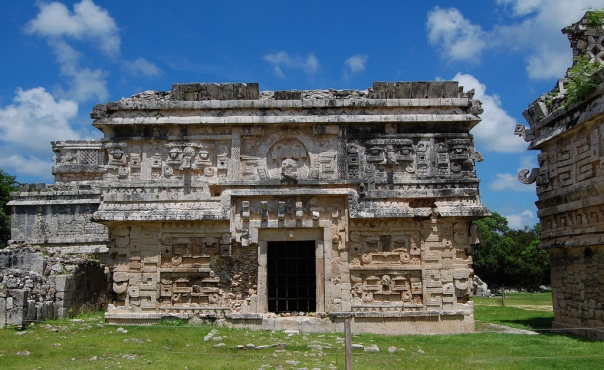
"La Iglesia" - an example of pre-Toltec, classal Puuc style architecture. These light and intricately detailed buildings are a great contrast to the later, more totalitarian architecture. The imagery of death and blood is largely absent from this older section of the city.
The oldest visible remaining architecture here represents the Puuc (“hill” in Mayan) style and was probably built around 900AD. Sometime soon after that time, Chichén Itzá underwent a huge upheaval. This was the end of the Classic Period, when the great civilization of the south was collapsing (for reasons unknown, but probably tied, at least in some way, to overexploitation of the environment).

Temple of the Warriors, in the domineering style of the Toltec-influenced period. The columns in front were once supported an enclosed complex- perhaps an administrative building.
As many of the major centers of Mayan civilization collapsed, Chichén Itzá came under great Toltec influence- the Toltecs had their capital at Tula, in the west, near Mexico City, and were the precursors to the Aztecs. Whether the Toltec influence was via direct invasion or via the Itzá Mayans is still debated. Either way, the city became deeply connected to the ideology of Central Mexico- an ideology which was strongly connected to the idea that the perpetuation of earthly life was only guaranteed by sacrifice to the gods- a bloody, bellicose tradition that is exemplified throughout the newer portions of the city. The very same spectacular architecture that captivates visitors today seems, in some ways, to be desperate expression of a culture in decline, a culture trying to keep hold of itself….
In short, the older portions of the city demonstrate a deep connection to its Classic Mayan predecessors, via the Puuc tradition; and the newer portions (ca. AD 1000) demonstrate a fractured, and more desperately extreme time, highly swayed by outside forces. I have read that anywhere from 35,000 to 90,000 people lived here at its peak- a huge number for ancient times.
Turmoil continued into the 1200’s, after which point the city finally declined totally, being absorbed by the Spanish in the second half of the 1500’s.
If you really want to truly appreciate this astounding place, find a way to come early in the morning- i.e. stay in a local town. We arrived at around 9am and had the place to ourselves- in the midday, just as the sun is becoming unbearable, (which is amazingly taxing on the brain, as we dizzily found out) hoards upon hoards of day-trippers arrive on buses, and what is so tranquil in the morning becomes a cattle run. We thankfully managed to stay a few steps ahead of the crowds. Definitely bring a ton of water, and be prepared to bake like you’ve never baked before in the extreme sun.
Notable sights:
Templo de Kukulcan
This immense pyramid is rife with calendrical numerology. There are 91 steps on each of the 4 sides. These 364 steps, plus the final step at the top before the altar correspond to the solar year. The pyramid is terraced into 9 sections divided by a staircase, commemorating the 18 20-day months of the Mayan calendar. Each of the four facades includes 52 panels, which correspond to the 52 year cycle of the Mayan long-count calendar. On the vernal and autumnal equinoxes, a serpent-shaped shadow appears to descend the steps in the form of Kukulcan, (something like the Mayan version of Quetzalcoatl)
The Great Ballcourt
There are 8 ballcourts at Chichen Itza, and this is the largest, and the largest in MesoAmerica.
It is spectacularly huge (about 300ft long) and the acoustic effects within, like at other places in the city, are extraordinary.
The rules and meaning of the game changed over history and according to region, but it was played in many cultures for centuries and sometimes included some degree of ritual bloodshed
Some of the deathly imagery surrounding the ballcourt:
Group of a Thousand Columns
This vast complex was once enclosed and perhaps was a focal point of governmental administration. Nearby, there are ruins of a bathhouse which housed both steam and cold baths.
El Caracol
The Spanish gave El Caracol its name because of the spiral staircase within. It is an immense observatory, built in a Classic style common further south- There are chac mool’s (a seated figure) dedicated to the rain god at each cardinal point and the windows in the tower are aligned with Venus and other stars at certain times of year.
The movement of the stars, and the calendar was integral to Mayan spirituality and worldview. The Mayans were perhaps the most astronomically sophisticated people in the world before the Renaissance and were able to predict eclipses centuries in advance, and to track the path of planets with great accuracy.
Cenote Sagrado
In the riverless Yucatán, settlements were often built near the numerous sinkholes, or cenotes, which dot the limestone region. Following a sacbe (a Mayan road with white pavement) from the city center, one finds this life-water of the city. In the early 20th century, archeologists found evidence of human sacrifice at the bottom of the Sacred Cenote. This is also the place which gives the city its name – Chichén (“near the well” of the Itzá (an ethic group that existed in this area))
a simple home
Most of the residences in the city were probably wooden structures much like some present-day Mayan homes. They have rotted away ages ago. But this stone structure has lasted somewhat. It was once someone’s home in the middle of the great city, possibly that of someone who tended one of the nearby temples. So many men, women, and children came and went through that door, living their day-to-day lives…
etc.
